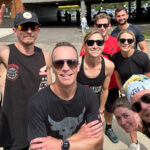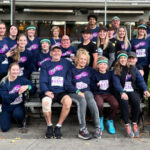The Chicago Marathon takes place Sunday, marking the fifth of six Abbott World Marathon Majors of the calendar year.
The race, which hosts some 50,000 participants, is known for its fast, flat course with Kenya’s Kelvin Kiptum winning last year’s race in a world-record-setting two hours, 35 seconds (Kiptum died earlier this year in a vehicle accident).
Runners looking to race Chicago can secure automatic entry if they hit time standards, have finished the Chicago Marathon five or more times within the last 10 years, run with a charity bib, register with a tour group, or complete three events in the Bank of America Chicago Distance Series. Those who don’t qualify for automatic entry can put their names in a lottery.
Runners hoping to get into next year’s race by running the time standard for their age category may need to double check the time they need to chase; standards for most categories for the 2025 race were made faster earlier this year.
This year, the Brainsport Times is speaking to Saskatoonians who’ve completed the World Marathon Majors about their experiences getting into and running these coveted races. Today, 50-year-old Bernell Anstey shares her story of running the 2023 Chicago Marathon.
Tell me a bit about yourself and your relationship with running.
I began running eight years ago, at the age of 42.
Growing up, I figure skated, played ringette, and was on the school basketball and curling teams. In my 20s and 30s, I was not regularly physically active.
In my late 30s, I had a gym membership with good intentions of going regularly, but that did not happen. I mentioned to my husband that it might be helpful to have an elliptical at home and, for my 40th birthday, he surprised me with a treadmill. For two years, it sat in the basement collecting dust.
When I was 42, I dusted off the treadmill and began some short, slow runs. While they were difficult to begin with, they became easier. Even though I had friends who ran, I didn’t tell anyone about my treadmill running.
I began to feel I was making progress and enjoying the challenge. I took a leap and bought a Garmin to track my progress, then took another leap and decided it was time for try a 5-km race, so I registered for the Spring Run Off at Elbow thinking it might be a good opportunity to run a race where no one would know me. As my training progressed, I felt I could run the 10 km, so switched and successfully completed it. I continued to run and began telling my friends.
I heard about the Boston Marathon and how runners aspired to run this prestigious marathon. Without being fully aware of the distance of a marathon, I casually commented to my husband and two sons that maybe one day I would run the Boston Marathon. My youngest son was excited to hear about this, as he was a Boston Bruins fan, and told his friend that his mom was going to run the Boston Marathon. I became somewhat embarrassed, and vividly remember telling him that he couldn’t say that, as what I had said was just a “crazy” thought and would never happen.
I decided I wanted the challenge of running a half marathon and joined a running clinic at Brainsport that included runners training for the full marathon. Many of the runners had completed many of the World Majors, including the Boston and New York marathons. The group, coached by Pat Somerville, was very welcoming, supportive, and encouraging. Coach Pat and the group, along with my other running friends, helped me train for my first half marathon at the Saskatchewan Marathon, and also for the full marathon at Edmonton later that year.
My training for the Edmonton Marathon was disrupted by a foot injury and I ended up running missing my Boston qualifying time by four minutes. On my second marathon, I successfully qualified for Boston, which I first ran in 2019. Since that time, I have been very fortunate to have qualified each year for Boston. I am grateful to have run it four times, with the plan of returning next year. Given my initial thought that running the Boston Marathon was just a “crazy” dream, Boston definitely holds a special place in my heart.
After accomplishing your goal of running the Boston Marathon, why did you want to run Chicago?
After completing the Boston Marathon and later New York City (in 2022), I felt it was time to run the Chicago Marathon and earn my third World Majors star. I was also eager to run a fast, flat course (both Boston and New York City are famously hilly).
How did you get in?
I had a qualifying time from the previous Boston Marathon.
What did your training look like for the Chicago marathon?
The first two months of my training went very well; I was hitting my paces and distances. Unfortunately, 10 weeks out from the marathon, I fell from my road bike and experienced a significant shoulder injury in which I had a dislocation and torn ligaments.
My doctor cleared me to ride a stationary bike with my arm in a sling to maintain my fitness. Coach Pat quickly pivoted my training to indoor biking as I was fortunate to have found a used Peloton bike to purchase. When I was cleared by my physio to resume running seven weeks prior to the marathon, the goal was to run the marathon, but with a revised finish time. Coach Pat continued to supplement spins to support my running until I toed the start line. I believe the biking strengthened my legs and cardio, helping to build fitness. I recall being surprised on my long run three weeks prior to the marathon, when I was comfortably able to run paces that I was not expecting to be able to run.
I know how difficult it is to sustain an injury or illness while training and how those injuries and illnesses may impact training differently for everyone. In my case, I was very fortunate to have been able to use indoor cycling to help maintain my fitness and supplement my training. It can be extremely disappointing and frustrating when you are faced with obstacles that may impact the goal that you have been working so hard towards but, from my experience, I think it’s important to reach out to those on your team (e.g., doctor, physiotherapist, coach) to see if there are other options to help support your fitness until you are able to resume running.
Tell me about the race.
I arrived at the race early, feeling very uncertain about how the race was going to go. I wasn’t sure if my injured shoulder would cause discomfort, or what pace I would be able to sustain. It actually felt very similar to running my first marathon.
The weather was ideal; it was about 5C at the start, with little wind. I knew that my GPS was not going to be reliable for the first several miles due to the high buildings, so I connected my Stryd foot pod to a second watch that I wore to help monitor my pace until the GPS was accurate.
I felt great throughout the marathon. I recall feeling very relaxed and actually listening to the lyrics of my music. During the first half, I realized I had to focus on slowing my pace down, but even with that, I came through the first half over a minute quicker than planned. On the second half, I continued to feel comfortable up until the last two miles. One of the toughest parts for me was the out and back near the end of the race when you can see runners who are ahead of you and on the home stretch. I ended up crossing the finish line in 3:32:30, which was a personal best. Given the length of time I was off running due to my injury, and not knowing what to expect, I was very surprised and pleased by the outcome.
The energy on the course was amazing. There are lots of landmarks that you run by; it was very scenic. It was also easy for my husband to navigate the subway system; he was able to see me several times on the course, which was definitely motivating.
One of the fun highlights about the Chicago Marathon is that they offer Goose Island beer to runners at the finish line, it’s a nice way to celebrate the 26.2 miles.
How logistically easy or challenging was it to organize travel and accommodations?
It was very easy to organize travel and accommodations. I booked my hotel through the housing site on the marathon website. While my hotel was not downtown, it was very easy to get around on the subway.
In comparison to Boston and New York where you have to rely on transportation to get to the start lines at Hopkinton and Staten Island, Chicago is much simpler in that the race begins and finishes in Grant Park which is easy to access by the subway.
How did the race compare to the other marathons you have done?
Chicago is a fantastic race. The course is flat and fast, and there are so many iconic landmarks that you pass by.
There is amazing crowd support throughout the entire course, and yet it is not that crowded that your family and friends can spot you and cheer you on.
The expos and race were both very well organized.
Chicago is a beautiful city; the attractions, shopping, and food, including the deep-dish pizza, are fantastic.
What advice would you give to someone who runs Chicago?
It is important to have a team of people to support you. Training for a marathon is a commitment; it takes time and energy, along with many sacrifices. It is important that you have people to support you on your journey, whether it be family, friends, a coach, a running group, a physiotherapist, a massage therapist. During your training, obstacles may pop up; that is when it is critical to rely to on the support of others.
When you get to the start line, know that all of your hard training has prepared you for the race. Enjoy the race, take it all in, and celebrate your accomplishment!
Anything else?
My final thought would be to believe in yourself, celebrate your successes, and never stop chasing your dreams!









